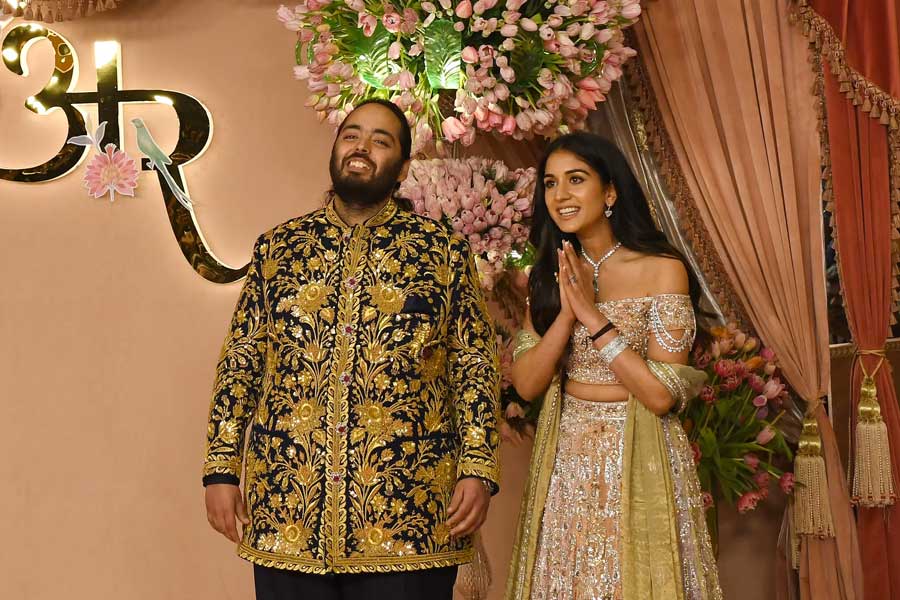"Her voice is full of money," he said suddenly. That was it... It was full of money – that was the inexhaustible charm that rose and fell in it, the jingle of it, the cymbals’ song of it.
F. Scott Fitzgerald (The Great Gatsby)
The Ambanis have done it again. From over $100 million in 2018, when Isha Ambani got married, to $600 million now with Anant Ambani having finally tied the nuptial knot, the estimated price tags on these eye-popping, jaw-dropping, Beyonce-Rihanna starring wedding bashes have left all of us in awe, one Mr Jay Gatsby included.
Why? Because we are all enamoured by wealth, especially when gift-wrapped in ostentation while showcasing for the world a big fat Indian wedding. The world media has been agog. "One of the most lavish weddings in history," cried Le Monde. "Crazy richest wedding ever," said NBC as The New York Times declared knowledgeably that the latest marriage spectacle involving the youngest Ambani scion had put "the unapologetic Indian billionaire on the global stage”. In sync, many in India see this with pride too, Ambani's private gala succeeding in turning the global spotlight on what the West dubs India's Gilded Age, far removed from the poverty it was once associated with.
It is nobody's case that the uber-rich Ambanis do not have the right to spend their wealth in whatever manner they wish, be it on a 400,000 sq feet, 27-storey family residence in tony South Mumbai or on their children's weddings replete with rubies the size of popsicles, big names in world entertainment flown in on private jets, and thousands of designers, tailors musicians and carpenters working behind the scenes. It is also true that we Indians, irrespective of financial worth, tend to go over the top with weddings. Those who have money spend way beyond their means. And those who don't borrow, beg or steal to pull off what must be a grand show. It is a desperate attempt to stay afloat in societal hierarchies, even if, as someone joked, courtesy dinner plates emblazoned with State Bank of India logos as the “key sponsor of this match made in heaven”.
But in the case of the Ambanis (the $600-million bill bandied about is barely 0.5 per cent of Mukesh Ambani’s net worth) it is the sheer spectacle of it all, the presence of the big-league influencers and celebrities with extended receptions and dinner spreads at multiple party venues on land and sea, that sets them apart from, say, a Warren Buffet or Azim Premji, both self-made billionaires who have consciously shunned public display of opulence. In plainspeak, Asia's richest man and his family showboating a celebrity parade of entertainers and former world leaders at the ultra-luxury wedding of their son when two wars are playing out on the international stage says a lot about India and the family at the helm of its largest corporate entity spanning interests in almost everything between oil, textiles, retail and telecommunications. The sentiments go well beyond finger-wagging or firing memes at the rich. The concerns are serious, embarrassing to even have to point them out.
All this when at home, India is living through a time of existential disparities exacerbated by a dizzying rise in financial inequalities. In 2000, India had nine billionaires, says an Oxfam report. Now in 2024, India has 200 billionaires, collectively holding around $1 trillion in wealth, according to Forbes. India’s richest 1 per cent now own more than 40 per cent of the nation’s wealth. It is as though the Ambani wedding is picture-framing this moment: the wealthy getting wealthier and the poor... Never mind.
Showing off is a disgraceful character trait to harbour, we were told at home and in school. A former prime minister of India reminded us about it over a decade and a half ago. Apparently turned off by extravagant weddings and parties thrown by the rich and famous, Manmohan Singh, even while lauding Indian industry's success in wealth creation, sounded a word of caution. Showing off riches through ostentatious parties is as good as insulting the less privileged, he told a Confederation of Indian Industry AGM, while reminding business titans that India, with over one billion people, still faces the problem of scarce natural resources on a per capita basis.
Singh's wise counsel is worthy of being recalled for the benefit of the "Great Gatsbys" of India. The nouveau riche centrepiece of Fitzgerald's timeless novel about class, wealth and the hollowness of the American Dream written in 1925 is not so fictional in 2024 after all. Then again, if there's one thing that the even richer class Gatzby encounters lacks, it is empathy, which the voice of the novel, Nick Carraway, will find out. His father had cautioned him early in life that "a sense of the fundamental decencies is parcelled out unequally at birth." So, those repulsed by the latest reality show coming out of India, hold your tongue.
That evening at the wedding, as light from the chandeliers flickered off Anant Ambani's 72-carat emerald brooch, it must have dazzled many a gushing guest. Likewise, many of those who read about, or saw media photographs of, the jewel manufactured under Cartier supervision, must have been equally enamoured. See what we have become, see where India has reached, they must have thought, brimming with pride. For the remaining others who are willing, and able, to look harder, the shining rays of light also touched upon another reality: there's little in today's world worth celebrating.

